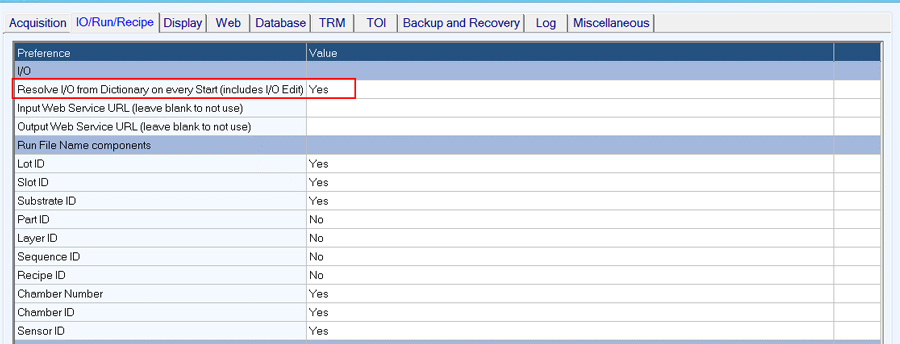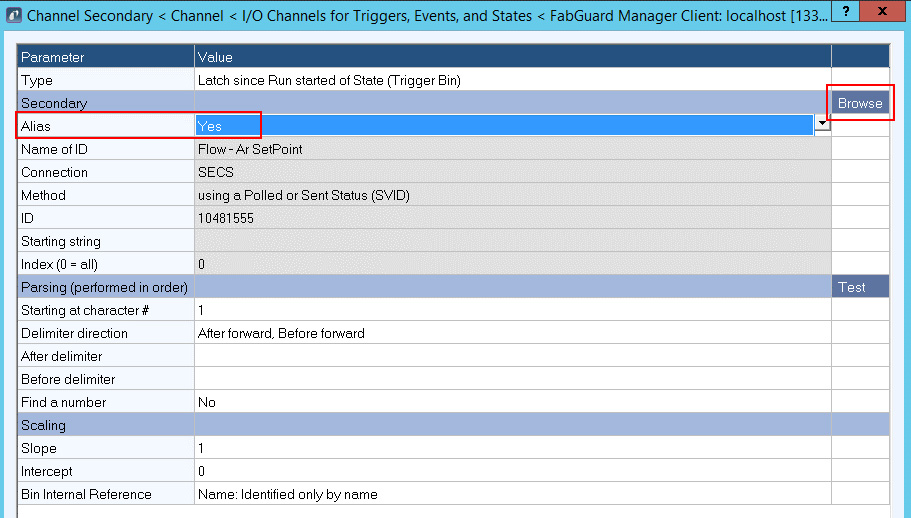Simplify Trigger Deployment Using Aliasing and Placeholders in I/O
 |
Acquisition Dictionary Background
The Acquisition Dictionary is key to increasing the speed of a FabGuard® FDC deployment by enabling the usage of a common data collection recipe across a tool platform/family. For example, the data collection recipe can be configured to use an Alias Bin for a parameter such as Chamber Pressure. Inside of the Acquisition Dictionary, Chamber Pressure for that tool type is assigned the SVID value 1001 for Chamber 1, 1002 for Chamber 2, and 1003 for Chamber 3. Right before the data collection recipe runs, FabGuard will resolve the Alias Chamber Pressure into the correct SVID value from the Acquisition Dictionary.
Easy Deployment and Standardization across Tool Family/Platform
The addition of placeholders and aliases in I/O (FabGuard versions 19.05.03+) combined with the Acquisition Dictionary, are able to efficiently resolve tool to tool differences in tool hardware configurations, such as mass flow controller assignments.
Using aliases in I/O triggers makes deployment and standardization of I/O even easier:
- Copying I/O channels from one chamber to second of a kind (SOAK) chambers
- No editing of triggers needed to account for SVID differences between Chamber X and Chamber Y
- Deploying an entire I/O from one tool to a SOAK tool, or cloning a tool
- No editing of Latch of Secondary triggers needed to account for the difference in gas configurations from tool to tool
Before You Begin: Enable the Global Preference
Prior to using aliases in I/O, enable the following global preference (Figure 1.)
- Navigate to Global Preferences Configuration > IO/Run/Recipe > I/O > Resolve I/O from Dictionary on every Start.
- Select Yes.
- Click OK to save the changes.

Figure 1: Enable Global Preference to resolve I/O from the dictionary.
Enter Alias and Placeholder Bins into the Acquisition Dictionary
Placeholder Bins are used in the Acquisition Dictionary when a tool does not have a definition for a Bin. For example, the table below shows when to use an SVID and when to use a placeholder in the Acquisition Dictionary for tools where not all gasses are configured.
Gas |
Tool 1 |
Tool 2 |
|---|---|---|
N2 |
Present, use SVID value |
No, use Placeholder |
O2 |
Present, use SVID value |
No, use Placeholder |
Ar |
No, use Placeholder |
Yes, use SVID value |
CH4 |
Yes, use SVID value |
No, use Placeholder |
|
Table 1: When to use SVIDs and Placeholders in Acquisition Dictionary entries for two tools. For more information, see help topic "Acquisition Dictionary Main Screen" and help topic "Secondary Information" section "Placeholder Data Source." |
||
Using Aliasing in I/O
When editing I/O triggers, primary and secondary entries can be added from the Acquisition Dictionary using the browse button (Figure 2.)
- Edit an I/O trigger secondary.
- Click Browse to select an entry from the Acquisition Dictionary.
- The Alias parameter will be set to Yes.
- If a Placeholder was selected, the Connection will be set to Placeholder.
- Click OK to save the changes.

Figure 2: Secondary Channel with aliasing enabled for an SVID.
Summary
FabGuard I/O can now utilize the benefits of defining primary and secondary values as aliases. This functionality allows I/O to leverage the Acquisition Dictionary to reduce trigger complexity, and makes deployment and standardization of I/O easier across tools of the same type.